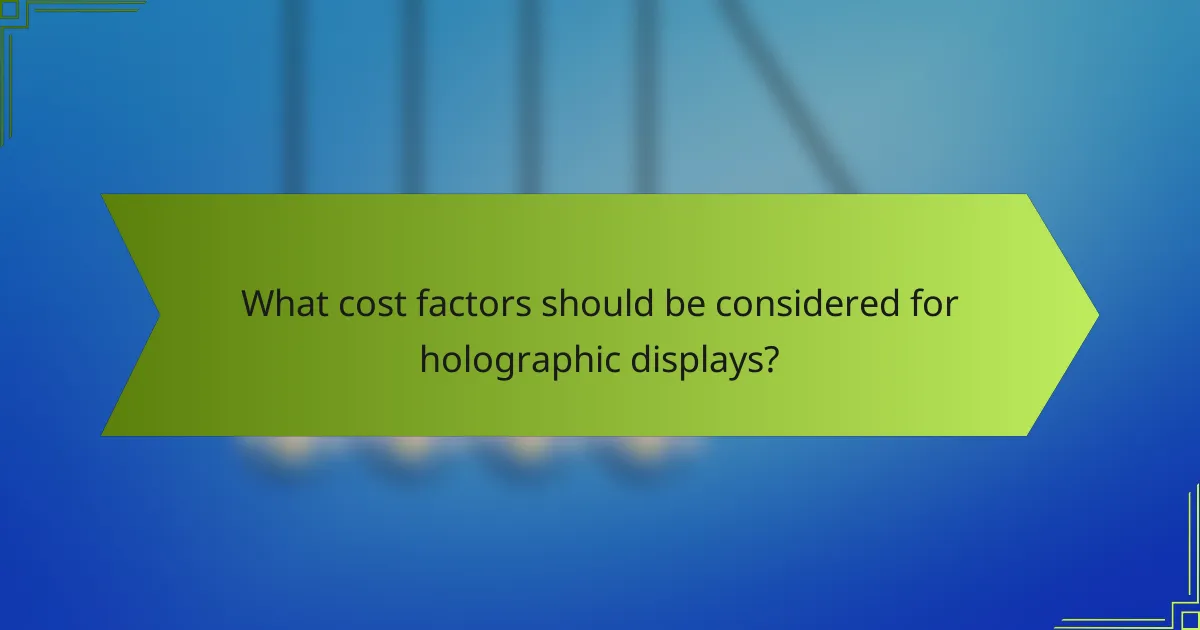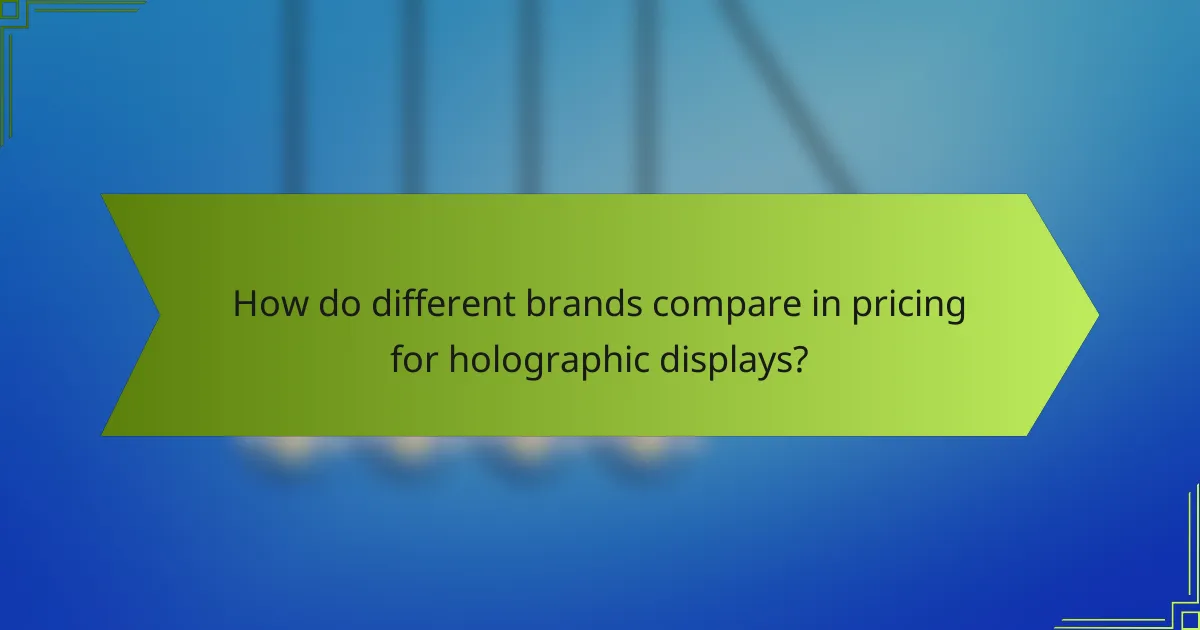When considering the purchase of holographic displays, budgeting expectations can vary widely based on the type and intended use of the technology. Consumers may find prices ranging from a few hundred to several thousand dollars, while commercial models can escalate to tens of thousands. Key cost factors include the technology specifications, installation and maintenance expenses, and the costs associated with content creation, all of which play a crucial role in the overall investment.

What are the budgeting expectations for holographic displays in the US?
Budgeting for holographic displays in the US can vary significantly based on the type and intended use. Consumers can expect to spend anywhere from a few hundred to several thousand dollars, while commercial models may range from several thousand to tens of thousands of dollars.
Average cost range for consumer models
Consumer holographic displays typically range from around $300 to $2,000. Lower-end models may offer basic features suitable for casual use, while higher-end options provide enhanced resolution and interactivity. Brands like Looking Glass and Holoxica are notable in this space.
Average cost range for commercial models
Commercial holographic displays generally start at about $5,000 and can exceed $100,000 depending on the technology and features. These models are designed for professional applications, such as marketing, training, and design visualization. Companies like Microsoft and VividQ lead in this market segment.
Factors influencing pricing
Several factors affect the pricing of holographic displays, including display size, resolution, and technology type (e.g., light field vs. volumetric). Additional costs may arise from software compatibility, support services, and warranty options. It’s essential to assess the specific needs of your application to determine the best investment.
Market demand and technological advancements also play a role in pricing. As the technology matures, prices may decrease, making holographic displays more accessible to a broader audience. Always consider future-proofing your purchase by opting for models that can be upgraded or expanded.

What cost factors should be considered for holographic displays?
When budgeting for holographic displays, several key cost factors must be taken into account. These include the technology type and specifications, installation and maintenance costs, and content creation expenses, all of which can significantly impact the overall investment.
Technology type and specifications
The type of holographic display technology you choose will greatly influence costs. Options range from simple 2D holograms to advanced 3D displays, with prices varying accordingly. For instance, basic models may start in the low thousands of USD, while high-end systems can exceed tens of thousands.
Specifications such as resolution, size, and interactivity also play a role. Higher resolution displays typically command a premium, so consider your audience’s needs when selecting a system. A good rule of thumb is to balance quality with budget, ensuring the technology meets your requirements without overspending.
Installation and maintenance costs
Installation costs can vary widely based on the complexity of the setup and the environment. Basic installations may cost a few hundred to a couple of thousand USD, while more intricate setups, especially in commercial spaces, can reach several thousand. It’s advisable to obtain multiple quotes from professionals to find the best deal.
Ongoing maintenance is another factor to consider. Regular upkeep may involve software updates, hardware checks, and potential repairs. Budgeting around 10-15% of the initial investment annually for maintenance can help ensure your display remains functional and up-to-date.
Content creation expenses
Creating engaging content for holographic displays can incur significant costs. Depending on the complexity of the content, expenses can range from a few hundred to several thousand USD. Simple animations or graphics may be more affordable, while immersive experiences requiring advanced design and programming will be pricier.
Consider leveraging existing assets or collaborating with content creators to manage costs. Additionally, investing in training for your team can reduce reliance on external services, ultimately saving money in the long run.

How do different brands compare in pricing for holographic displays?
Pricing for holographic displays varies significantly among brands, influenced by features, technology, and intended use. Generally, consumers can expect to spend anywhere from a few hundred to several thousand dollars depending on the brand and model.
Microsoft HoloLens pricing
The Microsoft HoloLens is one of the leading holographic displays on the market, with prices typically starting around $3,500 for the standard version. This device is designed primarily for enterprise use, offering advanced features such as spatial mapping and hand tracking.
When budgeting for a HoloLens, consider additional costs for software licenses and accessories, which can add several hundred dollars to the overall investment. The HoloLens 2, with enhanced capabilities, can exceed $5,000, making it essential to assess your specific needs before purchasing.
Vive Pro pricing
The Vive Pro is another popular option, especially in the gaming and virtual reality sectors. Pricing for the Vive Pro typically starts around $800 for the headset alone, but a complete setup with necessary accessories can reach up to $1,400 or more.
When evaluating the Vive Pro, keep in mind that it requires a powerful PC to operate effectively, which can add to the total cost. Additionally, consider ongoing expenses for games and applications that utilize the headset’s capabilities.
Looking at Holoxica models
Holoxica offers a range of holographic display models, with prices generally starting from about $1,000 for entry-level options. These displays are often used in professional settings, such as medical imaging and engineering, where high-quality visuals are crucial.
While Holoxica models may be more affordable than some competitors, it’s important to evaluate their specifications and compatibility with your intended applications. Ensure that the model you choose meets your performance requirements to avoid additional costs down the line.

What are the key features affecting the cost of holographic displays?
The cost of holographic displays is influenced by several key features, including resolution, size, and interactivity. Understanding these factors can help you budget effectively and make informed purchasing decisions.
Resolution and image quality
Resolution significantly impacts the cost of holographic displays. Higher resolutions provide clearer and more detailed images, which can lead to a premium price. For instance, displays with resolutions above 4K are typically more expensive but offer superior visual experiences.
Image quality also encompasses color accuracy and brightness. Displays that support a wider color gamut and higher brightness levels often come at a higher cost. When budgeting, consider the intended use; professional applications may justify the investment in higher quality.
Size and form factor
The size and form factor of a holographic display directly correlate with its price. Larger displays generally cost more due to the increased materials and technology required. For example, a small tabletop holographic display might range from a few hundred to a few thousand USD, while larger installations can exceed tens of thousands.
Form factor also plays a role; portable models may be more expensive due to advanced engineering and materials. Assess your space and application needs to determine the most cost-effective size and form factor for your budget.
Interactivity features
Interactivity features can significantly raise the cost of holographic displays. Touch capabilities, gesture recognition, and voice control are examples of advanced interactivity that enhance user experience but come with higher price tags. Displays with basic functionality will be more affordable.
When considering interactivity, evaluate how essential these features are for your application. If high interactivity is not necessary, opting for a simpler model can help reduce costs without sacrificing essential display quality.

What are the expected ROI and cost-benefit analysis for businesses?
Businesses can expect a positive return on investment (ROI) from holographic displays through enhanced customer engagement and improved operational efficiency. A thorough cost-benefit analysis should consider initial setup costs, ongoing maintenance, and potential revenue streams generated by these innovative technologies.
Potential revenue generation
Holographic displays can significantly boost revenue by attracting customers and enhancing their experience. For instance, retailers using holograms for product demonstrations may see increased sales, with estimates suggesting a potential uplift of 20-30% in customer interest. Additionally, businesses can monetize holographic content through advertising partnerships or by offering premium experiences.
Cost savings through efficiency
Implementing holographic displays can lead to substantial cost savings by streamlining operations. For example, companies can reduce the need for physical prototypes or printed materials, which can be expensive and time-consuming to produce. By utilizing holograms for training or presentations, businesses can save on travel and material costs, potentially cutting expenses by 15-25%.
Long-term investment considerations
Investing in holographic technology is a long-term commitment that requires careful planning. Businesses should assess the lifespan of the technology and the potential for upgrades, as well as the evolving market demand for immersive experiences. A well-considered investment can yield benefits over several years, making it crucial to evaluate both current and future needs before committing funds.

What are the emerging trends in holographic display technology?
Emerging trends in holographic display technology include advancements in resolution, increased interactivity, and enhanced portability. These developments are shaping how holograms are used in various sectors, from entertainment to education, making them more accessible and practical for everyday applications.
Advancements in display resolution
Recent advancements in display resolution for holographic technology have significantly improved image clarity and detail. Higher resolutions, often exceeding 4K, enable more realistic and immersive experiences, which are crucial for applications like virtual reality and medical imaging.
When considering display resolution, it is essential to evaluate the pixel density and the viewing distance. A higher pixel density provides a clearer image, especially in close-up views, while the optimal viewing distance can vary based on the application. For instance, a resolution of 8K may be beneficial for close-range applications, while 4K might suffice for larger displays viewed from a distance.
Investing in higher resolution displays can lead to better user engagement and satisfaction. However, it is important to balance the cost with the intended use; for example, educational tools may not require the same level of detail as high-end entertainment systems. Always assess the specific needs of your project before making a decision.
